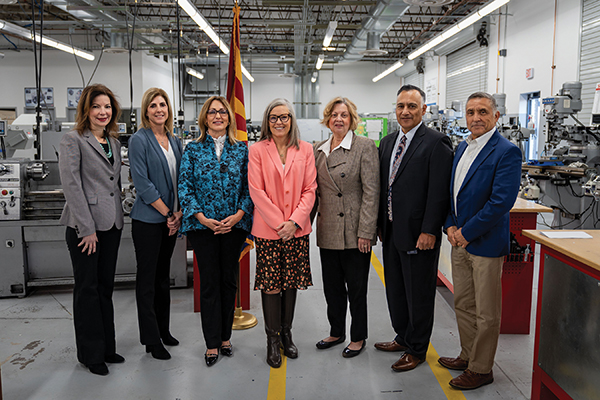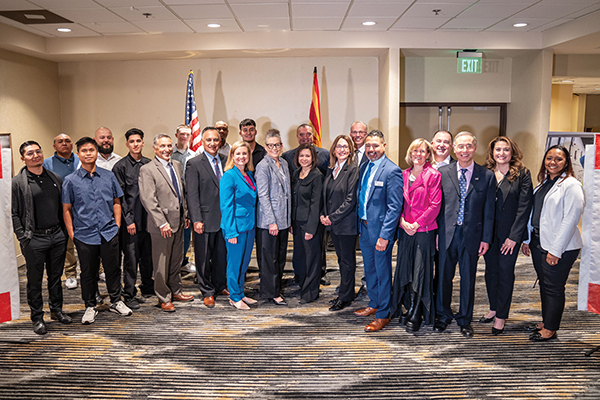
With the passage of the CHIPS Act in August 2022, U.S. policymakers and industry leaders set forth on an ambitious endeavor: building an end-to-end semiconductor manufacturing ecosystem on domestic soil. The historic legislation allocated nearly $53 billion to support manufacturing operations, research and development and workforce initiatives while establishing a 25 percent tax credit for capital investments.
More than two years later, one place in particular embodies the goals and vision of the CHIPS Act: Arizona.
Since 2020, Arizona leads the nation in new semiconductor investment, with more than $102 billion announced. During this time, companies have launched more than 40 expansion projects representing more than 16,000 projected new industry jobs. These projects span the entire ecosystem including leading-edge manufacturing, advanced packaging, research and development, equipment, supply chain and workforce development.
The implications of Arizona’s efforts reverberate across continents and industries. “No product is more central to international trade than semiconductors,” Chris Miller wrote in his 2022 book Chip War: The Fight for the World’s Most Critical Technology.
To maximize opportunities under the CHIPS Act and support industry growth, Arizona has launched an unprecedented collaborative effort, bringing together stakeholders from state and local governments, industry, trade groups, economic development organizations, universities and community colleges, workforce leaders and more.
Working together, partners have announced important new initiatives to enhance the state’s semiconductor ecosystem including new industry-led apprenticeships and workforce programs, investments in university infrastructure and R&D, first-of-its kind training accelerators at community colleges, a national industry roadmap and more.
Together, these efforts have the potential to transform the global economic and technology landscape for decades to come.
A Legacy of Semiconductor Innovation
For more than 70 years, Arizona has been a pioneer in semiconductor innovation. Scientists from Motorola began building some of the world’s first transistors in Phoenix in 1949. Thirty years later, Intel opened a new semiconductor fab, its first of what would grow to four by 2024 with two more currently under construction.
In 2020, Arizona grabbed global headlines as the destination of TSMC’s new high-tech fabrication facility. TSMC’s total investment in the state has grown to three announced fabs representing $65 billion in investment and 6,000 jobs. The first fab is scheduled to begin scale production in early 2025, with clients like Apple already identified.
Other global industry leaders with operations in the state include Applied Materials, NXP, Microchip, onsemi, EMD Electronics, Amkor, ASM, KoMiCo, JX Advanced Metals and more.
Accelerating R&D and Workforce Development
The surge in industry investment in Arizona has been matched by new initiatives to advance research and workforce development in the state.
To support enhancements to university infrastructure supporting researchers, students, entrepreneurs and industry partners, the Arizona Commerce Authority (ACA) invested more than $100 million, including:
• $47.5 million to Arizona State University, enabling the Materials to Fab Center at the university’s MacroTechnology Works, in partnership with leading semiconductor innovator Applied Materials, Inc.
• $35.5 million to the University of Arizona, enabling a major expansion of the university’s Micro/Nano Fabrication Center and advancing R&D and industry partnerships.
• $13 million to Northern Arizona University to launch the Microelectronics Metrology certificate program, training center and research laboratory.
• $4 million to establish registered apprenticeship programs for semiconductor technicians.
Arizona is also pioneering strategic partnerships to continue growing skilled talent.

New programs include the semiconductor-focused Future48 Workforce Accelerator training facility at GateWay Community College in Phoenix. Developed in collaboration with industry partners Intel, TSMC and NXP, the facility will offer customized, hands-on training and feature state-of-the-art manufacturing equipment.
Students will learn the basics of semiconductor processing including cleaning, probing, photolithography and automated handling as well as training in maintenance, programming and integration techniques involving robotic applications and industry devices.
The state is also pioneering new “earn-to-learn” training models, in which trainees receive on-the-job training, often as paid employees.
In the past six months, both TSMC and Intel have announced semiconductor apprenticeship programs with the support of state and local resources.
TSMC’s expanded Registered Technician Apprenticeship Program includes equipment, process, manufacturing and facility technician apprenticeships in coordination with local universities and community colleges.
“One of the top considerations in TSMC’s decision to expand (in Arizona) was the opportunity to tap a local and diverse talent pipeline and also to collaborate with a world-class U.S. education system,” said Rose Castaneres, president of TSMC Arizona. “Our first-of-its kind program for semiconductor technicians represents what’s possible when government, industry and education come together.”
In July, Intel chose Arizona to launch its inaugural U.S. registered apprenticeship program for manufacturing facility technicians in partnership with Fresh Start Women’s Foundation, the ACA and local partners. The selected apprentices will be full-time Intel employees as they learn the core competencies needed for facility technician roles through hands-on training, earning a certificate and college credit after successfully completing the program.
To support these apprentices and expand similar programs to additional employers, the ACA has launched the AZ Semi Career and Apprenticeship Network in partnership with the SEMI Foundation. Through the partnership, employers have access to customized training and curriculum as well as an established network of training providers, education institutions and community-based organizations.
Building Comprehensive Support Networks

A key feature of Arizona’s semiconductor advancement efforts has been its close alignment with industry leaders.
“Just about everything we do comes with the direction and leadership of industry, ensuring investment and training programs align closely with industry priorities,” said Sandra Watson, President and CEO of the Arizona Commerce Authority.
In anticipation of the CHIPS Act, in September 2021, Arizona convened more than 80 stakeholders from across the country to develop an industry-led blueprint to enhance U.S. semiconductor competitiveness. Released in December 2022, the National Semiconductor Economic Roadmap (NSER) establishes a baseline and a target across four domains — infrastructure, supply chain, workforce and entrepreneurship — using rigorous data and analyses.
NSER’s recommendations were put into action by the Arizona Semiconductor Task Force. Launched in August 2022, the Arizona Semiconductor Task Force represents a statewide effort convening more than 100 partner organizations from private industry, academia and the public sector to compete for all CHIPS Act funding opportunities, address gaps and grow the semiconductor ecosystem.
The group has convened eight full task force meetings as well as numerous subcommittee meetings in areas such as workforce, advanced packaging and the supply chain. Under the ACA’s leadership, the Task Force is focused on helping companies navigate their applications for direct incentives while leveraging Arizona’s unique capabilities and strengths to lead federal CHIPS research and development programs.
Arizona’s Bright Future
In recognition of Arizona's global leadership position, SEMICON West, North America’s premier microelectronics exhibition and conference, announced it will relocate to Phoenix on a rotating basis following 50 consecutive years in San Francisco. Arizona will host the conference starting in October 2025 and again in 2027 and 2029, with all three appearances at the Phoenix Convention Center.
“With our investments in creating a state primed for investment from semiconductor companies from around the world, I know Arizona can lead the country in advanced manufacturing and technology jobs,” said Governor Hobbs.
Learn more about Arizona’s leading semiconductor actions at www.azcommerce.com. T&ID
